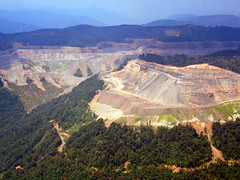
Remember T. Boone Pickens and his famous plan? There’s been much buzz today (for example) about an announcement of the downward revision of his original plans to one quarter the original scale. The change has been attributed to lower fossil fuel prices than when the plan was first put forth, as well as the credit crunch. However, Pickens is already on the hook for nearly 700 turbines, and he plans to make several smaller wind farms rather than the megafarm previously proposed. Most people seem to see this as an unfortunate turn of events, but a handful of smaller installations are a more sound strategy from most vantage points e.g; redundancy, minimizing impacts, etc. As for the diminished capacity, initial delivery is not due until 2011, so it there’s probably still time for things to pick back up.
(Update)
P.S. There seems to be a new wind installation in Harvard Square next to The Garage at Dunster & Mount Auburn. Give it a gander next time you’re in the area, and if you forget but it’s gusty out, you might just look up to figure out where that gentle whirr is coming from. (Click the image at right for a better view)



 The conservative backlash against the Waxman-Markey Cap and Trade bill has started.
The conservative backlash against the Waxman-Markey Cap and Trade bill has started.
 The controversial
The controversial 

